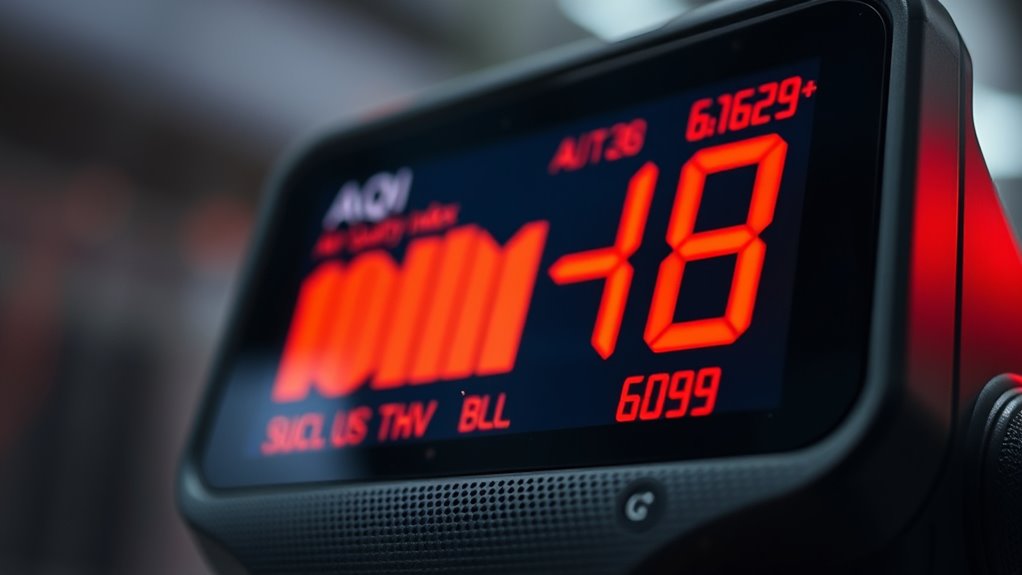The Air Quality Index (AQI) simplifies air pollution levels into a number from 0 to 500, helping you understand how clean or polluted the air is and what health risks to expect. Different ranges indicate if air quality is good, moderate, or hazardous, so you can take appropriate precautions like limiting outdoor activities or wearing masks. If you want to learn how to interpret these numbers and protect your lungs effectively, keep exploring to find out more.
Key Takeaways
- AQI simplifies complex pollution data into a number from 0 to 500, indicating air quality and health risks.
- Different AQI categories (Good, Moderate, Unhealthy) guide outdoor activity and health precautions.
- Monitoring specific pollutants like PM2.5, ozone, and NO₂ helps determine pollution levels and health impacts.
- Higher AQI values (above 100) increase risks of respiratory and cardiovascular issues, especially for sensitive groups.
- During poor air quality days, actions like closing windows, using air purifiers, and wearing masks protect lung health.
What Is the Air Quality Index?
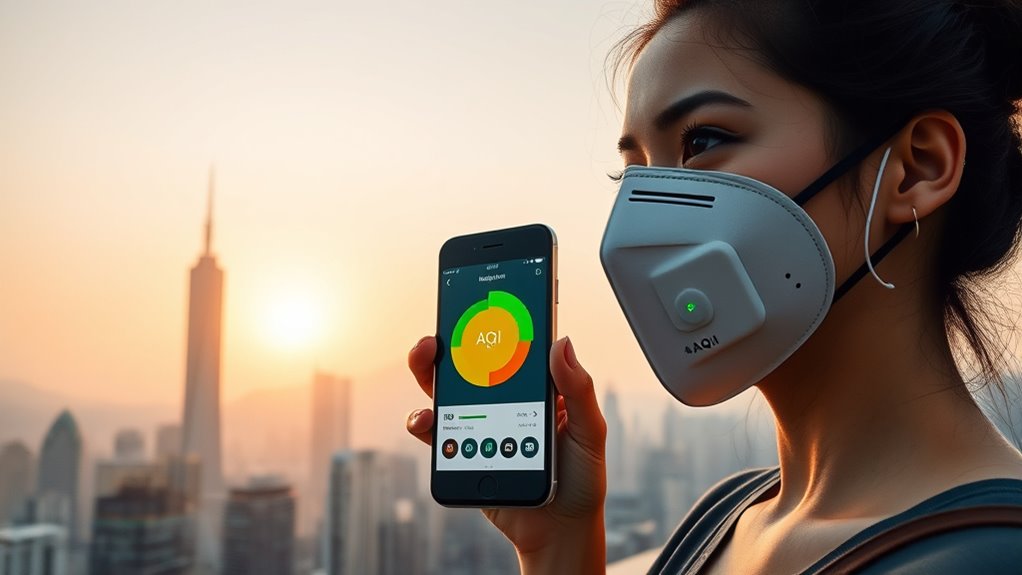
Have you ever wondered how air quality is measured and communicated? The Air Quality Index (AQI) is a tool that helps you understand pollution levels in your area based on air quality standards set by health authorities. It simplifies complex data from various pollution sources, like vehicle emissions, factories, and wildfires, into a single number. It also considers public health guidelines to determine safe and unsafe levels. The AQI ranges from 0 to 500, with higher numbers indicating worse air quality and greater health risks. When the AQI is high, it signals that pollution sources are releasing harmful particles and gases that can affect your lungs and overall health. By understanding what the AQI means, you can take appropriate health precautions to protect yourself, especially during days of poor air quality. Monitoring air quality data can help you stay informed and make healthier choices to reduce exposure. Additionally, being aware of the air quality index can help you plan outdoor activities and avoid high pollution times.
How Is AQI Calculated?

To calculate the AQI, environmental agencies monitor specific air pollutants that pose health risks, such as ground-level ozone, particulate matter (PM2.5 and PM10), carbon monoxide, sulfur dioxide, and nitrogen dioxide. They perform air sampling to collect pollutant data from various locations. Once samples are gathered, pollutant calculation determines the concentration levels of each pollutant. These concentrations are then converted into a standardized AQI value using established formulas. The process involves comparing pollutant levels to national air quality standards, translating raw data into a scale from 0 to 500. This scale helps you understand the air quality status and potential health impacts. Accurate air sampling and pollutant calculation are essential for providing reliable AQI values you can trust for health decisions, emphasizing the importance of vetted ID Times in ensuring data accuracy. Moreover, consistent monitoring protocols and data validation methods are crucial for maintaining the credibility of AQI reporting.
AQI Categories and Their Meaning
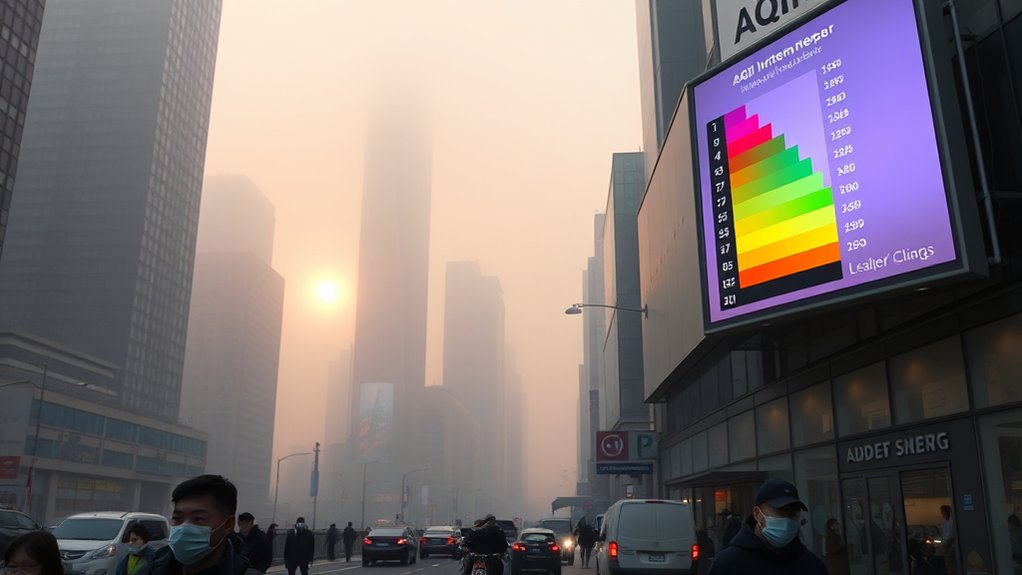
Ever wonder what the different AQI categories mean for your health? Understanding these categories helps you gauge pollution levels and protect your lungs. The AQI ranges from Good to Hazardous, reflecting pollutant sources and associated health implications. Here’s what each category indicates:
Understanding AQI categories helps you stay safe and protect your lungs from pollution.
- Good (0-50): Air quality is satisfactory, with minimal health risk.
- Moderate (51-100): Acceptable, but sensitive groups should consider limiting outdoor activities.
- Unhealthy for Sensitive Groups (101-150): Older adults, children, and those with respiratory issues may experience health effects. Proper ventilation can help mitigate indoor pollutant buildup during these times.
- Unhealthy (151-200): Everyone risks health effects; pollutant sources like vehicle emissions increase pollutant levels. Maintaining air quality awareness is essential to avoid health impacts.
- Very Unhealthy (201-300): Health alert; pollutant sources cause serious health effects. Increased public health efforts are often necessary during these levels.
- Hazardous (301-500): Emergency conditions; serious health implications for all. Implementing air purification devices can help reduce indoor pollutant levels in such conditions.
Common Pollutants Measured in AQI
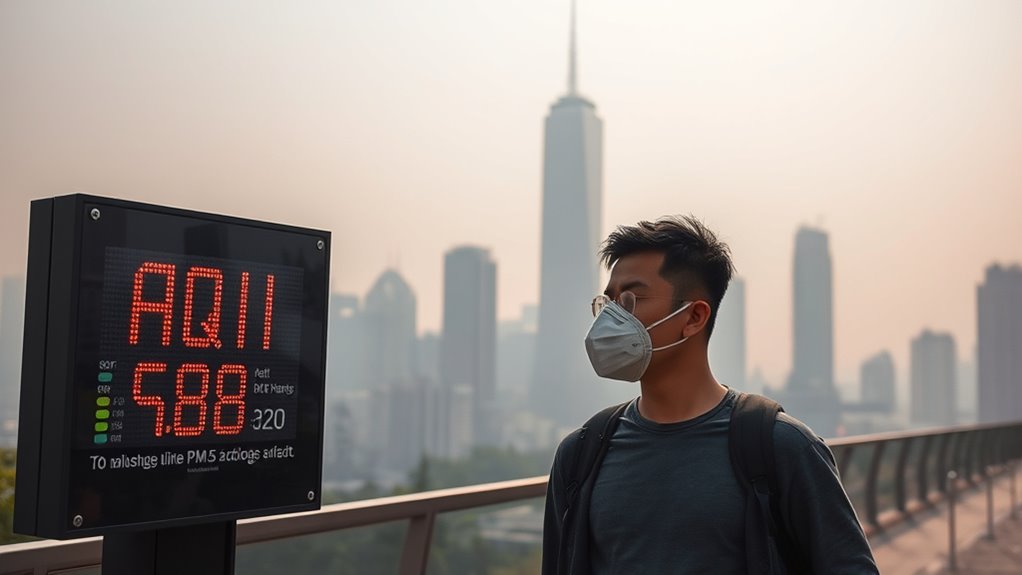
You should understand which pollutants the AQI measures to better grasp air quality. These major pollutants include ozone, particulate matter, carbon monoxide, sulfur dioxide, and nitrogen dioxide. Knowing how these are measured helps you interpret AQI readings accurately. Additionally, some air purifiers incorporate smart technology to monitor and improve indoor air quality effectively. This technology can also help detect pollutant levels in real-time, enabling more targeted responses. Understanding air quality standards is crucial for assessing health risks associated with different AQI levels. Moreover, awareness of indoor versus outdoor pollutants can help you take appropriate measures to protect your lungs in various environments.
Major Air Pollutants
What are the key pollutants that the Air Quality Index (AQI) measures to assess air quality? The main pollutants include substances that impact your lungs and overall health. These pollutants come from both human activities and natural sources.
- Particulate Matter (PM): Tiny particles from industrial emissions, vehicle exhaust, and natural pollutants like wildfires, which can clog your lungs.
- Ground-level Ozone (O₃): Formed when pollutants from factories and vehicles react in sunlight, irritating your airways.
- Nitrogen Dioxide (NO₂): Emitted primarily from burning fossil fuels, contributing to smog and respiratory problems.
- Sources of pollution can vary, but understanding lifestyle factors that influence air quality can help you make healthier choices.
Measurement Techniques
Measurement techniques for the common pollutants in AQI rely on specialized instruments and methods that detect and quantify each substance accurately. Air quality sensors play a crucial role, providing real-time data on pollutants like PM2.5, ozone, and nitrogen dioxide. These sensors are designed to deliver high measurement accuracy, ensuring that readings reflect actual air conditions. Techniques such as optical particle counters and electrochemical sensors are commonly used for precise detection. Calibration and maintenance are essential to maintain sensor reliability over time. Advanced measurement methods help identify pollution sources and track changes in air quality. Incorporating HEPA filtration technology into sensors can improve particle detection and overall accuracy. Additionally, the development of smart sensor networks enables more comprehensive monitoring across different environments, enhancing data collection and analysis. By using these sophisticated tools, you can trust the data to make informed decisions about protecting your lungs and reducing exposure to harmful pollutants.
How to Read and Interpret AQI Numbers
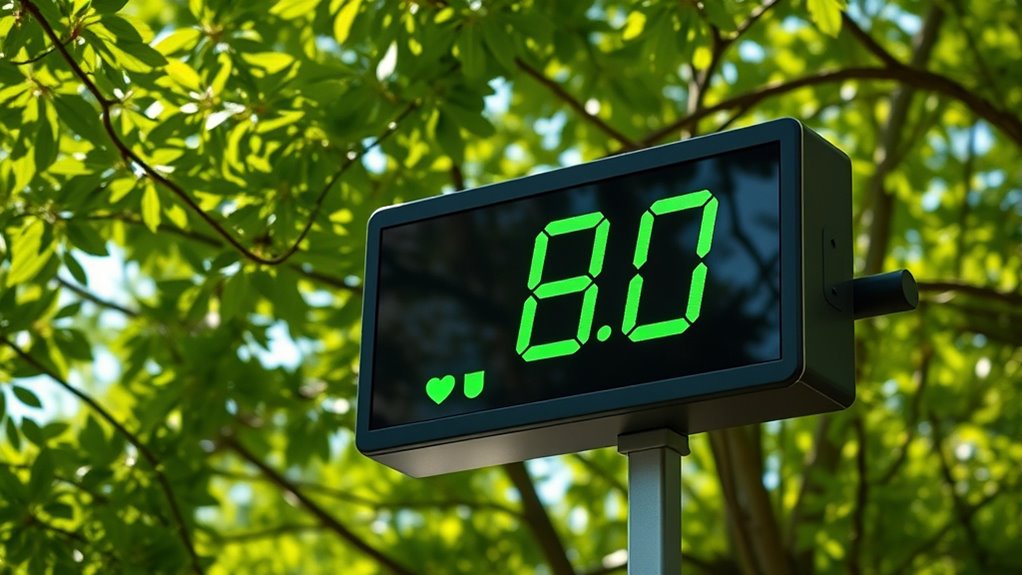
Understanding the AQI scale helps you quickly assess air quality. When you see a number, it indicates whether the air is safe or poses health risks. Let’s explore how to interpret these levels and what they mean for your daily activities. Familiarity with tuning options can also help you optimize vehicle performance for better efficiency and driving experience. Additionally, staying informed about air quality monitoring can aid in planning outdoor activities and minimizing health impacts. Recognizing that pollution sources influence AQI levels can further help you take proactive steps to protect your lungs, and understanding air quality indices enables you to respond appropriately to changing conditions.
AQI Scale Breakdown
The AQI scale translates complex air quality data into a straightforward number that indicates how clean or polluted the air is and how it might affect your health. When you see an AQI number, it tells you if the air is safe or if you should take precautions, especially during high traffic pollution days. Additionally, understanding the effects of air pollution can help you better assess risks and take appropriate protective measures. Remember: – 0-50 (Good): Air quality is satisfactory, and outdoor and indoor air quality pose little or no risk. – 51-100 (Moderate): Air quality is acceptable; people with sensitivities should limit prolonged outdoor activities. – 101-150 (Unhealthy for Sensitive Groups): Vulnerable groups, like children or those with respiratory issues, should reduce outdoor exposure. Knowing how to read these numbers helps you protect your lungs in busy traffic areas and improve indoor air quality. Also, being aware of air quality standards established by health authorities can guide you in making safer choices during pollution episodes. Recognizing the importance of data-driven strategies can further enhance your understanding of air quality patterns and improve your protective responses.
Interpreting Air Quality Levels
When you look at an AQI number, you’re seeing a simple way to gauge air quality and how it might impact your health. Lower numbers indicate good air quality, while higher numbers warn of potential health risks. Understanding these levels helps you recognize when air pollution sources, such as vehicle emissions or industrial activities, might be affecting outdoor air. It also alerts you to indoor air quality issues, like smoke, mold, or household chemicals, which can worsen health outcomes. The AQI categories provide guidance on precautions you should take, whether staying indoors during unhealthy levels or wearing masks when outdoor pollution is high. By interpreting these numbers accurately, you can better protect yourself and your family from the adverse effects of poor air quality.
Health Risks Associated With Different AQI Levels
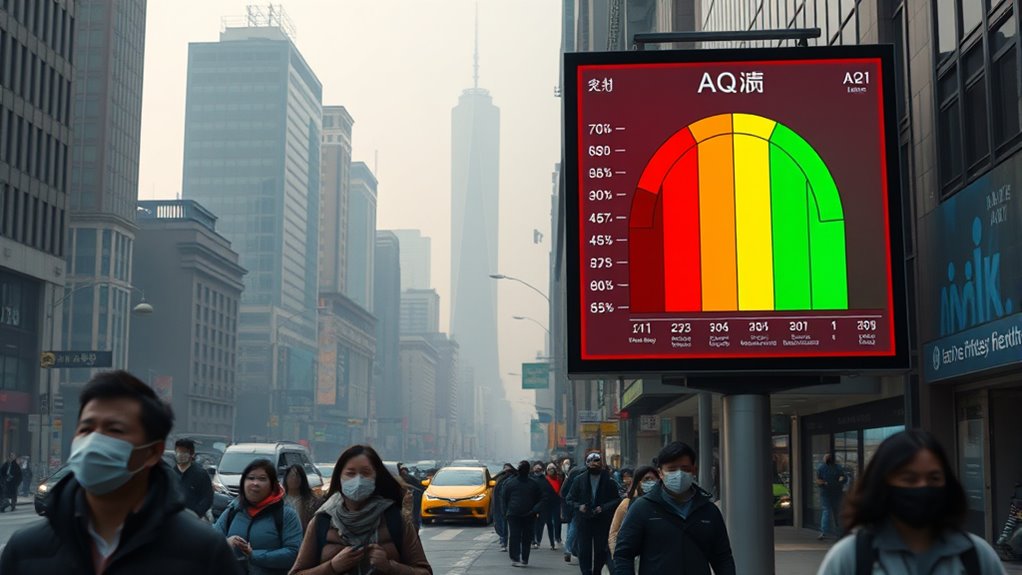
As AQI levels increase, so do the health risks associated with air pollution, and these dangers can vary considerably depending on the specific index range. At lower levels, most people experience minimal effects, but as levels rise, the risk of Respiratory issues, cardiovascular problems, and worsening of existing conditions grow. Poor indoor air quality can compound these risks, especially for sensitive groups. High AQI levels also pose occupational hazards for outdoor workers exposed to prolonged pollution.
Rising AQI levels increase health risks, especially for vulnerable groups and outdoor workers.
You might notice symptoms like:
- Irritated eyes, nose, or throat
- Shortness of breath or coughing
- Increased asthma attacks or lung discomfort
Prolonged exposure at elevated AQI levels can lead to serious health complications, emphasizing the importance of understanding these risks and taking precautions.
Tips for Protecting Yourself During Poor Air Quality

During periods of poor air quality, taking proactive steps can considerably reduce your health risks. First, improve your indoor air quality by keeping windows and doors closed, especially if outdoor pollution sources are high. Use air purifiers with HEPA filters to remove airborne particles, and avoid smoking or burning candles indoors. When outside, limit your time outdoors, particularly during peak pollution times, and try to stay in shaded areas away from heavy traffic. Wearing a properly fitted mask can also help filter out harmful pollutants. Keep track of local AQI reports to plan your activities accordingly. Regularly cleaning your living space and ensuring good ventilation when outdoor air quality improves further protect your lungs. Being mindful of outdoor pollution sources helps you make smarter choices during poor air quality days.
When and How to Take Action Based on AQI Readings

Monitoring the AQI regularly is essential to determine when to take action. When the AQI reaches unhealthy levels, you should prioritize improving indoor air quality and consider using personal protective equipment. If AQI readings are in the orange or red zones, it’s time to act:
- Close windows and doors to keep outdoor pollutants out
- Use air purifiers to improve indoor air quality
- Wear masks or respirators when going outside or handling pollutants
Taking these steps helps protect your lungs during high pollution days. Stay informed by checking AQI updates frequently, especially if you or family members have respiratory issues. Knowing when and how to respond guarantees you minimize exposure and maintain healthier indoor air quality, keeping you safer during poor air quality episodes.
Frequently Asked Questions
How Does Weather Affect AQI Readings?
Weather patterns and temperature fluctuations directly impact AQI readings. When winds pick up, they can disperse pollutants, lowering AQI levels, while calm weather may trap pollutants near the ground, increasing AQI. Hot days can worsen pollution due to increased ozone formation, and cold spells may reduce it. By understanding how weather influences air quality, you can better protect your lungs and plan outdoor activities accordingly.
Are AQI Levels the Same Worldwide?
You might wonder if AQI levels are the same worldwide. They’re not, because countries have different air quality standards and pollution sources. For example, urban traffic and industrial emissions vary globally, affecting AQI readings. So, a healthy AQI in one country might be considered unhealthy elsewhere. Always check local guidelines, understand pollution sources, and stay informed to protect your lungs no matter where you are.
Can Indoor Air Quality Impact AQI?
You might wonder if indoor air quality impacts AQI. The truth is, indoor pollution can profoundly influence overall air quality, especially if ventilation is poor. Poor ventilation traps indoor pollutants like dust, smoke, and chemicals, worsening air quality. While AQI mainly measures outdoor air, indoor conditions can spill outside, affecting local readings. So, good ventilation and reducing indoor pollution are essential for protecting your lungs and maintaining healthy air quality.
How Often Is AQI Data Updated?
You wonder how often AQI data updates. Typically, real-time monitoring provides updates every hour or even more frequently, ensuring you get current air quality info. This frequent data collection enhances data accuracy, helping you make timely decisions about outdoor activities or when to take protective measures. Keep in mind that updates may vary depending on your location and the monitoring system used, but overall, real-time info aims for the most accurate, up-to-date data possible.
What Are the Long-Term Health Effects of Poor AQI?
Think of poor air quality as slow, steady rain eroding a sturdy building—over time, your lungs suffer. Chronic exposure to polluted air increases your risk of respiratory diseases like asthma and COPD, causing long-term damage. You might not notice immediate effects, but the harm accumulates, weakening your lung function and making you more vulnerable to infections. Protect your lungs now to prevent lasting health issues down the road.
Conclusion
Think of the AQI as your personal weather forecast for your lungs. When it rises, it’s like a storm brewing — warning you to take cover. I once ignored a high AQI reading and spent days coughing; now I check the numbers daily. Staying informed helps you protect your breathing just like an umbrella shields you from rain. Remember, understanding AQI turns you into your own air quality hero, keeping your lungs safe and healthy.
